Qi Qi
FinGAIA: An End-to-End Benchmark for Evaluating AI Agents in Finance
Jul 23, 2025



Abstract:The booming development of AI agents presents unprecedented opportunities for automating complex tasks across various domains. However, their multi-step, multi-tool collaboration capabilities in the financial sector remain underexplored. This paper introduces FinGAIA, an end-to-end benchmark designed to evaluate the practical abilities of AI agents in the financial domain. FinGAIA comprises 407 meticulously crafted tasks, spanning seven major financial sub-domains: securities, funds, banking, insurance, futures, trusts, and asset management. These tasks are organized into three hierarchical levels of scenario depth: basic business analysis, asset decision support, and strategic risk management. We evaluated 10 mainstream AI agents in a zero-shot setting. The best-performing agent, ChatGPT, achieved an overall accuracy of 48.9\%, which, while superior to non-professionals, still lags financial experts by over 35 percentage points. Error analysis has revealed five recurring failure patterns: Cross-modal Alignment Deficiency, Financial Terminological Bias, Operational Process Awareness Barrier, among others. These patterns point to crucial directions for future research. Our work provides the first agent benchmark closely related to the financial domain, aiming to objectively assess and promote the development of agents in this crucial field. Partial data is available at https://github.com/SUFE-AIFLM-Lab/FinGAIA.
Optimal Auction Design in the Joint Advertising
Jul 10, 2025Abstract:Online advertising is a vital revenue source for major internet platforms. Recently, joint advertising, which assigns a bundle of two advertisers in an ad slot instead of allocating a single advertiser, has emerged as an effective method for enhancing allocation efficiency and revenue. However, existing mechanisms for joint advertising fail to realize the optimality, as they tend to focus on individual advertisers and overlook bundle structures. This paper identifies an optimal mechanism for joint advertising in a single-slot setting. For multi-slot joint advertising, we propose \textbf{BundleNet}, a novel bundle-based neural network approach specifically designed for joint advertising. Our extensive experiments demonstrate that the mechanisms generated by \textbf{BundleNet} approximate the theoretical analysis results in the single-slot setting and achieve state-of-the-art performance in the multi-slot setting. This significantly increases platform revenue while ensuring approximate dominant strategy incentive compatibility and individual rationality.
ChronoSteer: Bridging Large Language Model and Time Series Foundation Model via Synthetic Data
May 15, 2025



Abstract:Conventional forecasting methods rely on unimodal time series data, limiting their ability to exploit rich textual information. Recently, large language models (LLMs) and time series foundation models (TSFMs) have demonstrated powerful capability in textual reasoning and temporal modeling, respectively. Integrating the strengths of both to construct a multimodal model that concurrently leverages both temporal and textual information for future inference has emerged as a critical research challenge. To address the scarcity of event-series paired data, we propose a decoupled framework: an LLM is employed to transform textual events into revision instructions, which are then used to steer the output of TSFM. To implement this framework, we introduce ChronoSteer, a multimodal TSFM that can be steered through textual revision instructions, effectively bridging LLM and TSFM. Moreover, to mitigate the shortage of cross-modal instruction-series paired data, we devise a two-stage training strategy based on synthetic data. In addition, we also construct a high-quality multimodal time series forecasting benchmark to address the information leakage concerns during evaluation. After integrating with an LLM, ChronoSteer, which is trained exclusively on synthetic data, achieves a 25.7% improvement in prediction accuracy compared to the unimodal backbone and a 22.5% gain over the previous state-of-the-art multimodal method.
Unlocking the Potential of Linear Networks for Irregular Multivariate Time Series Forecasting
May 01, 2025Abstract:Time series forecasting holds significant importance across various industries, including finance, transportation, energy, healthcare, and climate. Despite the widespread use of linear networks due to their low computational cost and effectiveness in modeling temporal dependencies, most existing research has concentrated on regularly sampled and fully observed multivariate time series. However, in practice, we frequently encounter irregular multivariate time series characterized by variable sampling intervals and missing values. The inherent intra-series inconsistency and inter-series asynchrony in such data hinder effective modeling and forecasting with traditional linear networks relying on static weights. To tackle these challenges, this paper introduces a novel model named AiT. AiT utilizes an adaptive linear network capable of dynamically adjusting weights according to observation time points to address intra-series inconsistency, thereby enhancing the accuracy of temporal dependencies modeling. Furthermore, by incorporating the Transformer module on variable semantics embeddings, AiT efficiently captures variable correlations, avoiding the challenge of inter-series asynchrony. Comprehensive experiments across four benchmark datasets demonstrate the superiority of AiT, improving prediction accuracy by 11% and decreasing runtime by 52% compared to existing state-of-the-art methods.
MergeQuant: Accurate 4-bit Static Quantization of Large Language Models by Channel-wise Calibration
Mar 07, 2025Abstract:Quantization has been widely used to compress and accelerate inference of large language models (LLMs). Existing methods focus on exploring the per-token dynamic calibration to ensure both inference acceleration and model accuracy under 4-bit quantization. However, in autoregressive generation inference of long sequences, the overhead of repeated dynamic quantization and dequantization steps becomes considerably expensive. In this work, we propose MergeQuant, an accurate and efficient per-channel static quantization framework. MergeQuant integrates the per-channel quantization steps with the corresponding scalings and linear mappings through a Quantization Step Migration (QSM) method, thereby eliminating the quantization overheads before and after matrix multiplication. Furthermore, in view of the significant differences between the different channel ranges, we propose dimensional reconstruction and adaptive clipping to address the non-uniformity of quantization scale factors and redistribute the channel variations to the subsequent modules to balance the parameter distribution under QSM. Within the static quantization setting of W4A4, MergeQuant reduces the accuracy gap on zero-shot tasks compared to FP16 baseline to 1.3 points on Llama-2-70B model. On Llama-2-7B model, MergeQuant achieves up to 1.77x speedup in decoding, and up to 2.06x speedup in end-to-end compared to FP16 baseline.
OIPR: Evaluation for Time-series Anomaly Detection Inspired by Operator Interest
Mar 03, 2025



Abstract:With the growing adoption of time-series anomaly detection (TAD) technology, numerous studies have employed deep learning-based detectors for analyzing time-series data in the fields of Internet services, industrial systems, and sensors. The selection and optimization of anomaly detectors strongly rely on the availability of an effective performance evaluation method for TAD. Since anomalies in time-series data often manifest as a sequence of points, conventional metrics that solely consider the detection of individual point are inadequate. Existing evaluation methods for TAD typically employ point-based or event-based metrics to capture the temporal context. However, point-based metrics tend to overestimate detectors that excel only in detecting long anomalies, while event-based metrics are susceptible to being misled by fragmented detection results. To address these limitations, we propose OIPR, a novel set of TAD evaluation metrics. It models the process of operators receiving detector alarms and handling faults, utilizing area under the operator interest curve to evaluate the performance of TAD algorithms. Furthermore, we build a special scenario dataset to compare the characteristics of different evaluation methods. Through experiments conducted on the special scenario dataset and five real-world datasets, we demonstrate the remarkable performance of OIPR in extreme and complex scenarios. It achieves a balance between point and event perspectives, overcoming their primary limitations and offering applicability to broader situations.
Uncovering the Impact of Chain-of-Thought Reasoning for Direct Preference Optimization: Lessons from Text-to-SQL
Feb 17, 2025



Abstract:Direct Preference Optimization (DPO) has proven effective in complex reasoning tasks like math word problems and code generation. However, when applied to Text-to-SQL datasets, it often fails to improve performance and can even degrade it. Our investigation reveals the root cause: unlike math and code tasks, which naturally integrate Chain-of-Thought (CoT) reasoning with DPO, Text-to-SQL datasets typically include only final answers (gold SQL queries) without detailed CoT solutions. By augmenting Text-to-SQL datasets with synthetic CoT solutions, we achieve, for the first time, consistent and significant performance improvements using DPO. Our analysis shows that CoT reasoning is crucial for unlocking DPO's potential, as it mitigates reward hacking, strengthens discriminative capabilities, and improves scalability. These findings offer valuable insights for building more robust Text-to-SQL models. To support further research, we publicly release the code and CoT-enhanced datasets.
ChatTime: A Unified Multimodal Time Series Foundation Model Bridging Numerical and Textual Data
Dec 16, 2024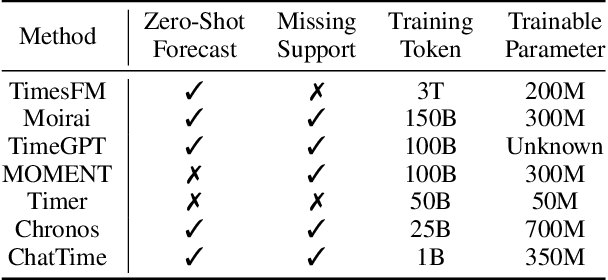
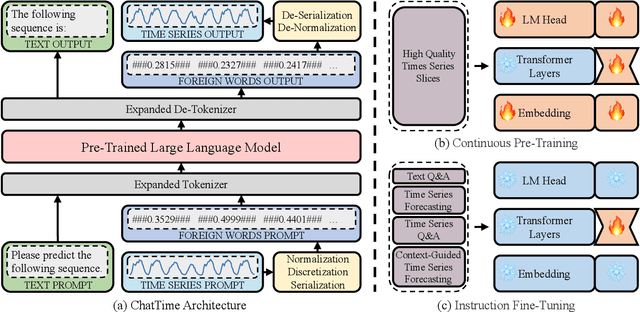
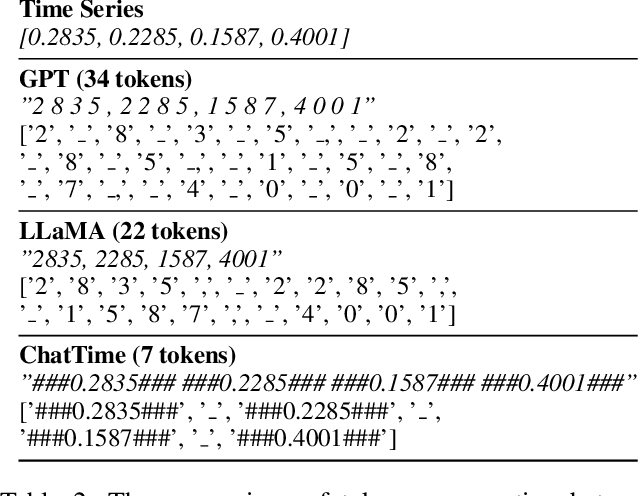
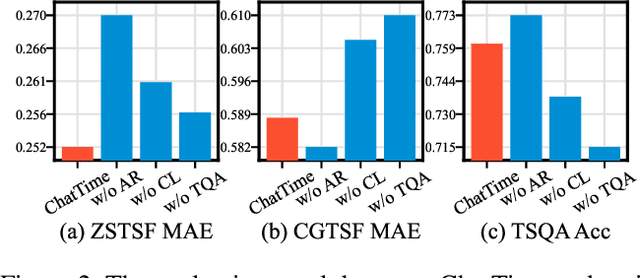
Abstract:Human experts typically integrate numerical and textual multimodal information to analyze time series. However, most traditional deep learning predictors rely solely on unimodal numerical data, using a fixed-length window for training and prediction on a single dataset, and cannot adapt to different scenarios. The powered pre-trained large language model has introduced new opportunities for time series analysis. Yet, existing methods are either inefficient in training, incapable of handling textual information, or lack zero-shot forecasting capability. In this paper, we innovatively model time series as a foreign language and construct ChatTime, a unified framework for time series and text processing. As an out-of-the-box multimodal time series foundation model, ChatTime provides zero-shot forecasting capability and supports bimodal input/output for both time series and text. We design a series of experiments to verify the superior performance of ChatTime across multiple tasks and scenarios, and create four multimodal datasets to address data gaps. The experimental results demonstrate the potential and utility of ChatTime.
Zero-shot Dynamic MRI Reconstruction with Global-to-local Diffusion Model
Nov 06, 2024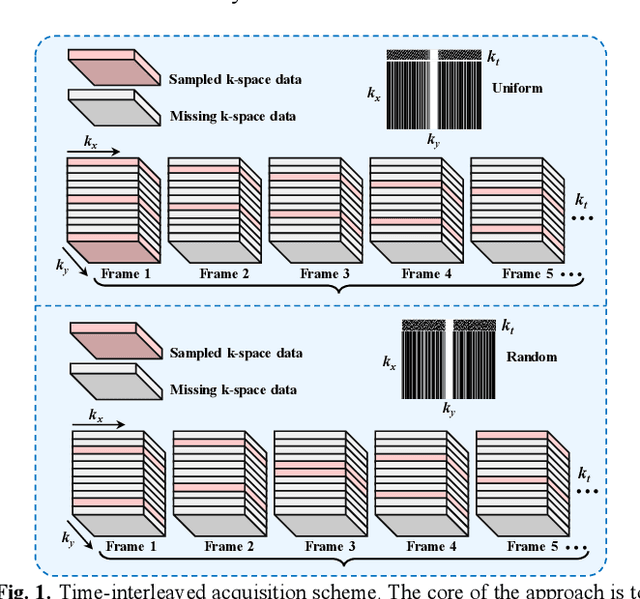
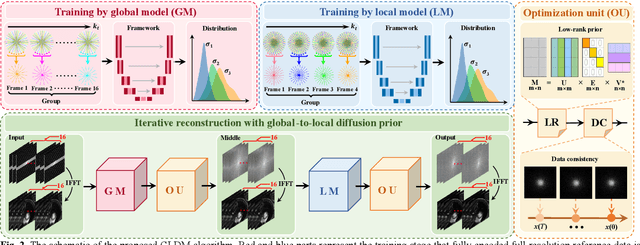
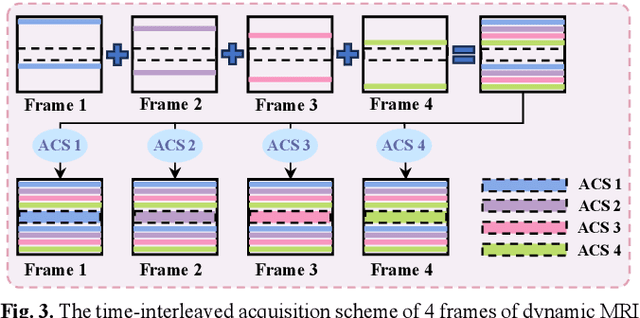
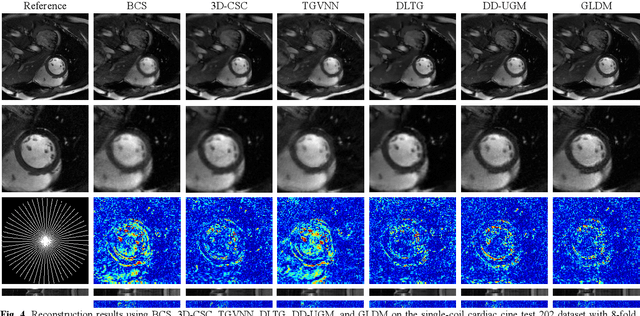
Abstract:Diffusion models have recently demonstrated considerable advancement in the generation and reconstruction of magnetic resonance imaging (MRI) data. These models exhibit great potential in handling unsampled data and reducing noise, highlighting their promise as generative models. However, their application in dynamic MRI remains relatively underexplored. This is primarily due to the substantial amount of fully-sampled data typically required for training, which is difficult to obtain in dynamic MRI due to its spatio-temporal complexity and high acquisition costs. To address this challenge, we propose a dynamic MRI reconstruction method based on a time-interleaved acquisition scheme, termed the Glob-al-to-local Diffusion Model. Specifically, fully encoded full-resolution reference data are constructed by merging under-sampled k-space data from adjacent time frames, generating two distinct bulk training datasets for global and local models. The global-to-local diffusion framework alternately optimizes global information and local image details, enabling zero-shot reconstruction. Extensive experiments demonstrate that the proposed method performs well in terms of noise reduction and detail preservation, achieving reconstruction quality comparable to that of supervised approaches.
SRAP-Agent: Simulating and Optimizing Scarce Resource Allocation Policy with LLM-based Agent
Oct 18, 2024



Abstract:Public scarce resource allocation plays a crucial role in economics as it directly influences the efficiency and equity in society. Traditional studies including theoretical model-based, empirical study-based and simulation-based methods encounter limitations due to the idealized assumption of complete information and individual rationality, as well as constraints posed by limited available data. In this work, we propose an innovative framework, SRAP-Agent (Simulating and Optimizing Scarce Resource Allocation Policy with LLM-based Agent), which integrates Large Language Models (LLMs) into economic simulations, aiming to bridge the gap between theoretical models and real-world dynamics. Using public housing allocation scenarios as a case study, we conduct extensive policy simulation experiments to verify the feasibility and effectiveness of the SRAP-Agent and employ the Policy Optimization Algorithm with certain optimization objectives. The source code can be found in https://github.com/jijiarui-cather/SRAPAgent_Framework
 Add to Chrome
Add to Chrome Add to Firefox
Add to Firefox Add to Edge
Add to Edge